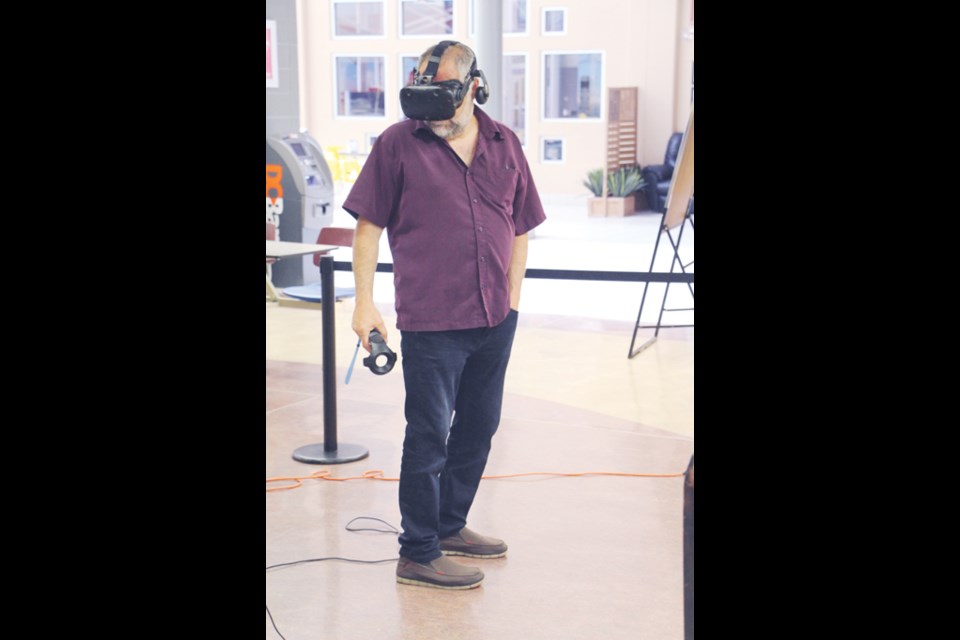In the middle of the Gallagher Centre, I walked into a bar. An old dive bar, it hasn’t seen a new coat of paint in years, but it’s filled with authentic blues and people milling about. Taking in the scene, behind my head, I hear a disembodied voice. “You can pick up the flyer on that stool, just teleport over there.”
That was the voice of Marco Luna, Research Associate, Concordia University Research Chair in Interactive Documentary. He was there with Cary Ciesielski from Twisted Pair Productions and Daniel Cross, Concordia University Research Chair in Interactive Documentary, as they presented the Introduction to VR panel at the Yorkton Film Festival. On the main floor, computers and VR headsets were set up to introduce festival attendees to virtual reality and the documentaries they are creating with it.
Luna and Ciesielski are doing very different things with the same format. Ciesielski’s films are similar to a traditional film. They’re realistic, linear documentaries told through filmed footage. The difference is that the stories are all around you, a panoramic display that surrounds the viewer. At one point in a documentary about the north, a man points at some snowmobiles, and you spin in your chair as you watch them travel.
One challenge of working in the new format is making sure people know where to look, but Ciesielski says that if he starts the action in the center of where people are looking when they put on the headset, they can follow that action.
“It’s quite possible that somebody could just watch nothing. They could watch the back of the image if they wanted to, but I don’t find that is the case.”
What Ciesielski is doing is taking people to places that they might otherwise be unable to go. One of his projects was a documentary on a traditional caribou hunt, for example, something in the far north that very few people would be able to experience, in conditions that not many people would be able to endure. Another project about paleontology and the discovery of Scotty the T-Rex was something regular people couldn’t see in person, because of where sites are and how protective paleontologists are of their dig sites.
“This doesn’t accidentally happen to you.”
The challenge for Ciesielski has been how you film without the ability to hide, how to light and get a shot while having a three hundred and sixty degree frame.
“You’re allowing the audience to be the cinematographer, they’re composing the shot.”
Luna, working on a companion piece to the film “I Am The Blues,” has created a location where the viewer wanders around “unlocking” pieces of video and parts of the story. It’s not finished – at one point I looked longingly at a drum set that Luna intends to make interactive but has not yet – but the pieces are there, and the potential for the setting is easy to see.
While Luna’s project uses some of the language of video games to work, he admits that it can be difficult to pitch a documentary to a gaming audience, as it’s a slower paced experience, and it’s not a gaming instinct to just sit and enjoy an experience.
“I’m a gamer, I play RPGs and MMOs, I notice that the gamer will have already acquired a mechanic where, you get inside a virtual world, and you have to collect the minimum necessary. You basically ditch information... You start putting information aside to accomplish the objective. When we start exposing gamers to this product, they don’t have the retention, they don’t stop and listen to someone else’s story, they always focus on what to do next.”
The big change for Luna is that he embraced coding, something many documentary filmmakers don’t necessarily know.
“I won’t be fooled by a game developer when they say it can’t be done. No, it can, you just don’t want to do it because it falls outside of your comfort zone.”
VR is new, and the rules are not yet known. Working through Concordia University, Luna says that they have had lots of failed projects, but that’s important for developing technology and finding out what it can do.
“We have a lab where we can really embrace error.”



